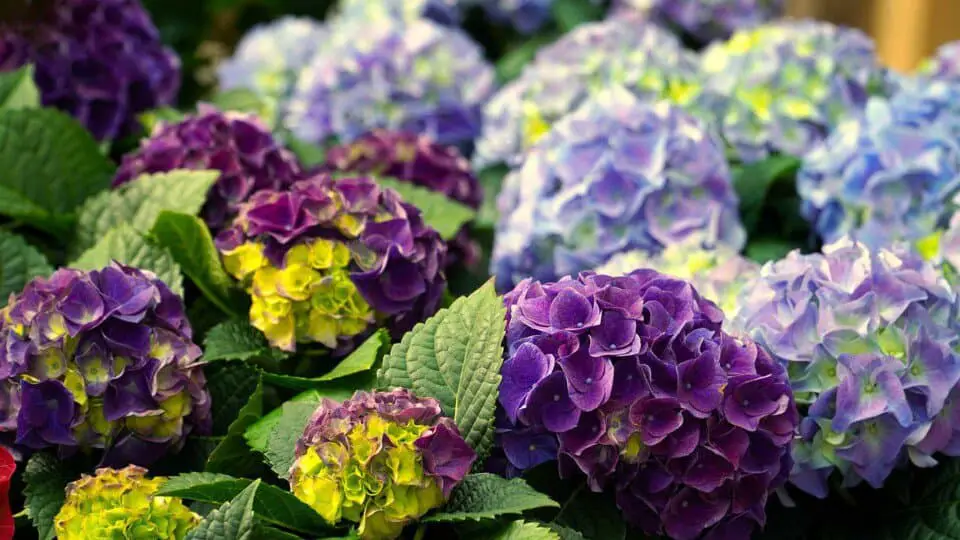Some links in the post are affiliate links and I get a commission from purchases made through some links found in the post.
Hydrangea is a beautiful garden and indoor plant with colorful blooms and beautiful foliage. The plant genus consists of 75 species and is native to the Americas and Asia.
It is impossible to have this fantastic, bushy plant in the yard and not fall in love with it. However, Sometimes they tell us that something is not right by turning the leaves yellow.
If your hydrangea leaves get yellow, it is important to know what is wrong with it to help it on time.
There are several reasons why the hydrangea leaves may be turning yellow. The causes could include fungal diseases, too much sun, chlorosis, lack of iron, lack of nitrogen, overwatering, root rot, and many more.
In order to help the leaves recover and stop turning yellow, first, the cause has to be determined and then the appropriate solution has to be found.
Since there are several causes of the hydrangea turning yellow, finding out the problem is the key. Therefore, in this article, we will discuss how to identify what is bothering the hydrangea and how to help it.
What are the Types of Yellowing on a Hydrangea?
Prior to discussing causes and solutions, let’s first categorize the different types of yellowings that may appear on the hydrangea’s leaves.
Generally, there are several types of yellow fadings that the hydrangea foliage may get.
Type 1: The Whole leave turns yellow and they drop off.
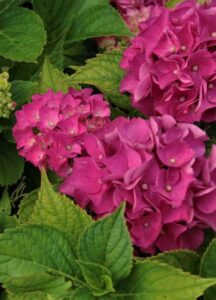 When all foliage of hydrangea turning yellow and starts to fall off from the stem, then it can be caused by several factors. One of the reasons may be the age of hydrangea.
When all foliage of hydrangea turning yellow and starts to fall off from the stem, then it can be caused by several factors. One of the reasons may be the age of hydrangea.
As the plant ages, it is part of the natural process for the leaves of hydrangea turning yellow. This often happens to the bottom leaves of the plant.
Another reason why the hydrangea leaves may completely turn yellow may be the lack of minerals in the process of flowering buds formation, too low temperature and cold, and the soil that is waterlogged.
Type 2: Veins stay green and the leaves get yellow color.
Another type of hydrangea turning yellow is when the veins of the leaves stay green and only the foliage gets the yellow color. This often is caused by chlorosis and iron deficiency.
Type 3: only the side parts of the foliage turn yellow.
When only the edges of the hydrangea turn yellow and the middle part remains green, this can be caused by the lack of nutrients, mainly the lack of iron content.
This can cause the lower edges of the foliage to get a yellow color.
Why is your Hydrangea Turning Yellow
We discussed the different types of yellow coloration that the hydrangea plants may get. Now, let’s discuss the causes of those colorations, how to identify them, how to cure them, and avoid the same happening in the future.
Hydrangea leaves are the main feeding source for the plant. Because of them, photosynthesis happens and the food for the plant is produced.
Chlorophyll is the substance that gives the foliage green color and absorbs light and air. Therefore, having yellow foliage can mess up the whole plant and its health.
This may be the sign that the plant asks for help and if you want the beautiful blooms to appear, then it is important to take care of it on time. There are several reasons for Hydrangea turning yellow:
1) Water Logging Caused by Overwatering
The primary cause of hydrangea turning yellow is overwatering. This plant requires soil that drains well and is consistently wet. The leaves will begin to droop and turn yellow if the soil is not draining correctly.
Additionally, a plant that has received too much water becomes soaked at the roots and is unable to breathe. Soon after, there will be stunted development, root rot from a fungus, and discolored leaves.
The incorrect watering of hydrangeas might be the cause of their yellowing foliage. Despite how much hydrangea plants adore water, wetlands are not places where they can grow and prosper.
Because of the ongoing moisture, the roots will begin to rot, and you will then notice the leaves gradually turning yellow. The entire plant might die if necessary precautions are not followed.
How To Avoid Water Logging
The plant will potentially start to rot and die if being overwatered and waterlogged. This happens because of the ongoing moisture. In order to help the plant in that case, you should cease watering or cut back on the frequency in this situation.
You can make sure in advance that the hydrangea is protected from water logging when planting it.
If having it in the pot, create a drainage layer at the bottom of the container Before planting or when transplanting, you can do it by putting the stones and broken bricks in the bottom.
This will help the plant with drainage and avoid water logging.
Hydrangeas require consistent watering. External variables and conditions directly affect how often to water.
However, make sure not to let the soil dry completely. In order to retain moisture and create proper drainage, you can also do mulching.
2) Dry Soil- Underwatering
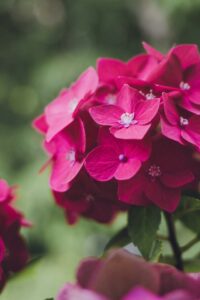
The signs of underwatering in hydrangea plants are quite similar to those of overwatering. Plants that receive insufficient moisture wilt, droop and cause the hydrangea to be turning yellow.
Poor watering schedules might lead to underwatering. Leaf discoloration is a big sign that your hydrangea needs water if do not water the hydrangea plant for a week or so.
The best solution for this is to ensure that the potting mix has good drainage and to keep the plant’s root zone wet without overwatering. It is recommended to water the hydrangea plant once a week, however, make sure to give enough water and not drown the plant.
Here is what you can do to save a underwatered hydrangea:
- If you have the hydrangea in the pot, then repot it. Take the plant out of the soil, remove the damaged and rotten roots, and replant in the fresh soil that is well-draining.
- If your hydrangea is located in open soil, such as in the garden, the overwatering may happen because of the location where it is placed. Sometimes, soil in some spots does not let the water run freely, and even if you are careful with the watering, it may still rot. So, another option is to relocate the plant.
How To Help Underwatered Hydrangea
First of all, never let the hydrangea soil dry out completely. You can give warm water twice a day to help the plant in the first place when being underwatered.
Mulching may be used to keep the soil wet for longer. Conifer cones, shreds, and wood chips can all be used as mulch.
If you want to avoid having the hydrangea underwatered in advance. When planting, make sure to place it away from the trees.
The shrubs may get damaged when it is planted closer to the trees, because of the competition for water, food, and nutrients.
If it is placed closer to the trees and other large-rooted plants, it won’t have enough water for life, development, and maintenance, it will begin to dry out.
3) Diseases
Houseplants with diseases have symptoms on their leaves and roots. For instance, root rot prevents the plant from receiving appropriate nutrition, and symptoms begin to appear on both the roots and the leaves.
If root rot fungal disease is not treated, drooping and yellowing leaves on hydrangeas may be an indication, and the plant may die.
Another frequent issue is leaf spot, a fungus that can cause hydrangea leaves to become yellow and develop dark or purple patches, especially on the underside of the leaves.
One of the most common diseases that the hydrangea plant may encounter is chlorosis and gray rot.
Hydrangea turning yellow may be caused by chlorosis. Mainly, when the leaves turn yellow and foliage stays green, the cause can be chlorosis.
How To Fight Hydrangea Diseases
You can treat the chlorosis by preparing a solution with 30 ml of potassium nitrate and 10L of water. After giving the treatment, for 30 days water the shrub once a week.
If the plant’s leaves over time start to turn yellow, then black, curl, and disintegrate, this may be because of the gray rot.
The hydrangea that is affected by the gray rot can be treated with an antifungal solution. Such a solution is 1 percent of Bordeaux’s combination.
4) Too Much Sun Or Too Little Light
Leaf scorch caused by too much sun exposure may be the reason for hydrangea turning yellow. If the damaged leaves are positioned in a way that they receive direct sunshine, yellowing from too much light is frequently a problem.
The leaves of hydrangeas will begin to droop and turn yellow if you expose the plant to full-day sunshine since they prefer partial sun.
Due to the harsh light, hydrangea leaves occasionally begin to turn brown and develop areas of discoloration. Hydrangea cannot endure direct sunshine.
Incorrect plant pot placement or the not-appropriate spot in the garden might cause the plant to completely dry out in addition to the leaves becoming yellow.
The most hazardous time for UV radiation is between 12 and 15 o’clock period.
Furthermore, hydrangea dislikes low light settings. It doesn’t feel good when larger bushes or tall plants with a luxuriant crown are blocking the light.
How To Help The Hydrangea Plant Receiving Too Much Sun
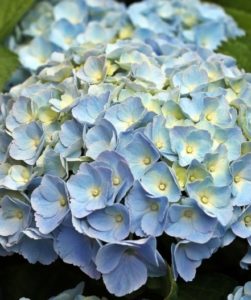
The optimum site to plant the hydrangea plant or to put the pot is where the afternoon sun shines for no longer than six hours.
Otherwise, the shrub can suffer from severe sunburn. The leaves may develop semi-transparent stains that later become yellow and dry.
Additionally, make sure that there are no other larger trees or plants shading the hydrangea plant. Too little light can also harm that plant just like too much light.
5) Low Acidity Level
The alkaline substrate is another factor contributing to the hydrangeas turning yellow. The leaves turn yellow when the pH is out of the ordinary.
Acidic soil feels fantastic to all hydrangeas. As a result, you should test to find this parameter before planting. because low acidity can cause leaves to yellow. Hydrangeas thrive on soil that has a pH between 5.5 and 6.5.
How To Fix Low Acidity Problem
You can easily change the pH of your potting soil if it is not acidic. To do this, water the soil with an acetic or citric acid solution every so often to acidify it (4-5 ml per 1L of water).
6) Lack Of Nutrition
Lack of nutrition is one of the most common causes of hydrangea turning yellow. Especially, this happens when the plant has Iron and Nitrogen deficiency.
This mainly results in the leaf tips becoming yellow and the new blooms that do not form properly.
One of the most crucial catalysts for the production of chlorophyll is iron. Without it, the leaves lose their vibrant green hue.
Therefore, if the vein of your hydrangea turns green but the borders turn yellow, the plant is clearly deficient in iron.
Iron chlorosis is the term used to describe the coloring that results from a lack of iron in plants. The signs of iron deficiency in hydrangeas are when the Leaves turn yellow while the veins stay green.
When the lower leaves of hydrangea turning yellow, and the plant is developing slower than regular, this may be because of nitrogen deficiency.
Fixing The Nitrogen and Iron Deficiency
Fixing a nitrogen deficit is simple, but you must first identify the cause. For instance, if you use an excellent indoor plant fertilizer on your plant and hydrangea turning yellow still, it’s probable that the nutrients are being washed out of the pot as a result of overwatering and excessively large drainage holes.
The good news is that by providing the plant with some iron and nitrogen, deficiency can be quickly corrected. Hydrangeas require regular feeding from early spring until mid-summer.
The plant needs more nutrients than usual before it begins to flow in the spring. The application of iron and nitrogen-rich fertilizers on time will solve the issue.
Final Thoughts
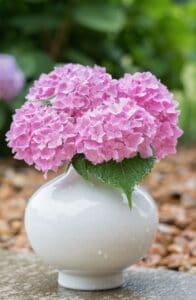 Hydrangeas are beautiful bushes that gift us with their wonderful blooms in summer. However, sometimes the green foliage of hydrangea turns yellow.
Hydrangeas are beautiful bushes that gift us with their wonderful blooms in summer. However, sometimes the green foliage of hydrangea turns yellow.
In the article above, we discussed possible reasons and the solutions to the hydrangea turning yellow. It’s not at all difficult to maintain lovely, healthy indoor plants.
The most important thing is to correctly and promptly care for the plant and to take preventative actions when necessary.
To prevent numerous illnesses and infections, make sure to follow its care guide and observe what your plant may be telling you.

